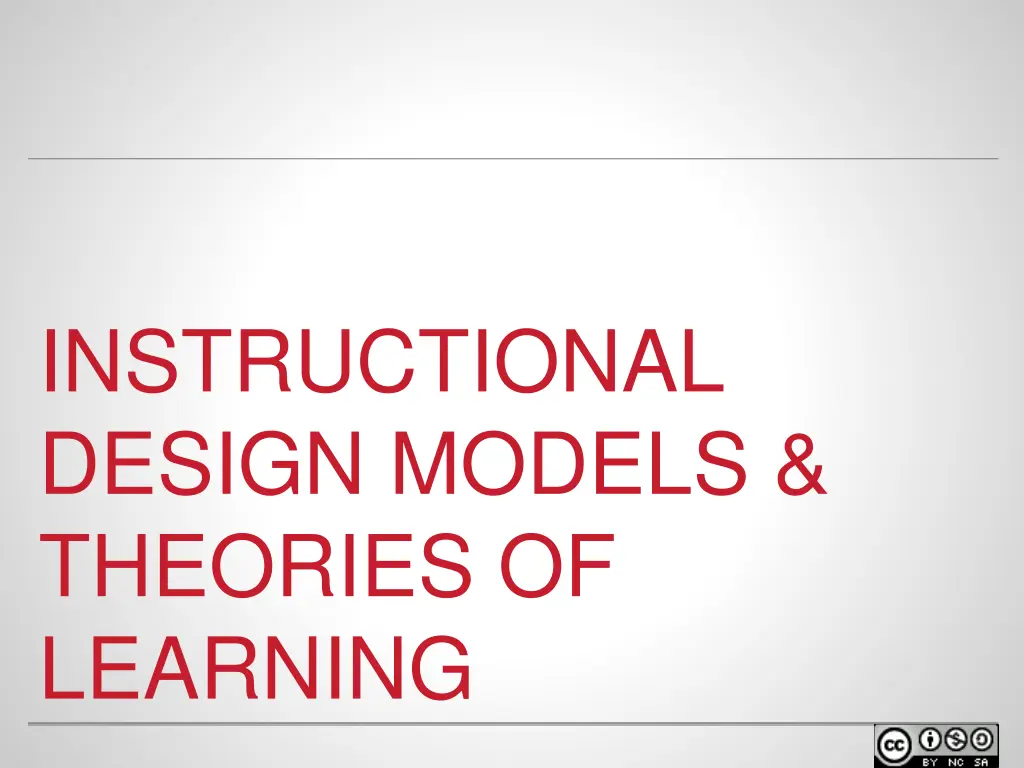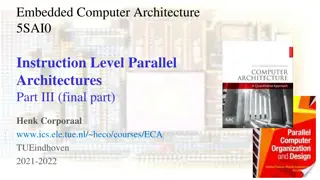
Exploring Instructional Design Models and Learning Theories
Dive into instructional design models and learning theories, identifying key characteristics and relationships, while considering steps for effective course design through systematic analysis and development processes.
Download Presentation

Please find below an Image/Link to download the presentation.
The content on the website is provided AS IS for your information and personal use only. It may not be sold, licensed, or shared on other websites without obtaining consent from the author. If you encounter any issues during the download, it is possible that the publisher has removed the file from their server.
You are allowed to download the files provided on this website for personal or commercial use, subject to the condition that they are used lawfully. All files are the property of their respective owners.
The content on the website is provided AS IS for your information and personal use only. It may not be sold, licensed, or shared on other websites without obtaining consent from the author.
E N D
Presentation Transcript
INSTRUCTIONAL DESIGN MODELS & THEORIES OF LEARNING
WELCOME o Facilitator name Position at university Contact info
LEARNING OUTCOMES By the end of this module, you should be able to: o Identify key characteristics of selected commonly-used instructional design models o Identify three main learning theories (behaviorism, cognitivism, constructivism) and their relationships to instructional design models o Recommend key steps for course/module design using instructional design and learning theory
AGENDA o What is instructional design (ID)? o Commonly used ID models Gagne s nine events of instruction ADDIE ARCS Backward design o A brief overview of learning theories (behaviorism, cognitivism, constructivism)
DISCUSSION o What is your understanding of instructional design?
WHAT IS INSTRUCTIONAL DESIGN? Grounded in theories of learning, ID is the process of analyzing learning goals and needs, and the systematic development of learning activities, materials, and assessment strategies to ensure learners achieve established learning outcomes.
BENEFITS OF INSTRUCTIONAL DESIGN o Serves the learning needs and success of students through effective presentation of content and fostering of interaction o Allows instructor to anticipate and meet potential concerns/ambiguities (when teaching online, it is potentially more difficult to adjust on the fly than it is in a classroom) o May help ensure the quality of a course o Gives structure to the student's process of working through course material
INSTRUCTIONAL DESIGN MODELS Video o Instructional design models
GAGNES NINE EVENTS OF INSTRUCTION 1. Gain attention 5. Provide learning guidance 2. Inform learners of objectives 6. Elicit performance (practice) 3. Stimulate recall of prior learning 7. Provide feedback 4. Present the content 8. Assess performance 9. Enhance retention and transfer to the job
ADDIE Analysis A Design D Development D Implementation I Evaluation E
ARCS Attention Satisfaction Relevance Confidence
BACKWARD DESIGN Deliberate design requires us as teachers to make an important shift in our thinking (it) involves thinking about (1) the specific learning sought, and (2) the evidence of such learning, before thinking about what we, as the teacher, will do or provide in teaching and (3) learning activities. (Wiggins and McTighe, 1998)
BACKWARD DESIGN Wiggins and McTighe, Understanding by Design To put it in an odd way, too many teachers focus on the teaching and not the learning. (Ibid.)
BACKWARD DESIGN Learning Outcomes Constructive Alignment Feedback and Assessment Methods Teaching and Learning Activities
BACKWARD DESIGN Fink s Integrated Course Design model: 1. Analyze learning context (situation) 2. Analyze learning content 3. Analyze characteristics of learners and teachers (learning process)
BACKWARD DESIGN Fink s Integrated Course Design model (continued): 4. Decide on goals focusing on active learning 5. Decide on assessment and feedback 6. Decide on learning activities 7. Make sure all elements are integrated (aligned) and the course is coherent
DEEP AND SURFACE APPROACHES TO LEARNING Video o Impact of course design on students approaches to learning
GROUP ACTIVITY: ID MODELS o Choose two or three elements or characteristics from any of the ID models that you would like to incorporate in your online module or course. o What is the reason for your choice? Include rationale for how your choice will encourage students to adopt a deep approach to learning.
THEORIES OF LEARNING Cognitivist theories (1960s, 1970s) Behaviorist theories Constructivist theories (1980s) (1950s, 1960s) How do people learn? Educational psychology
BEHAVIORISM - Rote memorization - Absorbing information (learner s mind as a blank box ) Learning - Motivated by positive and negative reinforcement Study of observable behavior - Positive and negative reinforcement - Lectures Teaching - Outcome-based (instructor- centered) - Drill and practice - Testing - Immediate feedback
COGNITIVISM - Problem solving - Organize information for successful information processing Learning - Recall of prior knowledge - Breaking down complex problems into components Study of mind - Lectures - Chunking of content Teaching - Graphic organizers, charts (instructor- centred) - Pre-tests/post-tests - Mnemonic devices, visual aids
CONSTRUCTIVISM - Focus on the whole rather than components Learning - Active learners who construct knowledge socially with peers and teachers Study of construction of meaning - Mini-lectures - Scaffolding (ZPD) - Reflective practice Teaching - Debates and role-playing (learner- centred) - Case studies - Experiential learning - Collaborative learning
CONNECTIVISM o A new theory of learning for the networking age (George Siemens and Stephen Downes)
THEORIES OF LEARNING Videos o Behaviorism, cognitivism, constructivism o Constructivism and online course design
GROUP DISCUSSION o Do you agree/disagree with any of the views and opinions about the three learning theories expressed in the video? o How do you apply elements from the three learning theories in your courses?
GROUP ACTIVITY: SYLLABUS RE-DESIGN o Working in your groups, discuss how this syllabus could be re-designed for an online course. (missing elements/information? redundant elements? best ways to display it in an online course? sequencing?)
TAKE HOME REFLECTION o With the learning theories we just discussed in mind, reflect on your own learning and teaching experiences. o Which learning theories best explain your own learning style? Why? What theories do you recognize in your teaching style? Explain.
SUMMARY o Benefits of instructional design o Key characteristics of commonly-used instructional design models (Gagne s Nine Events, ADDIE, ARCS, Backward Design) o Behaviorism, cognitivism, constructivism, connectivism o Applying instructional design and theories of learning to online course design
THANK YOU o Questions? o Comments? o Help? Contact information facilitator s and department s
REFERENCES Ally, M. (2004). Foundations of educational theory for online learning. In Terry Anderson and Fathi Elloumi (Eds.). Theory and Practice of Online Learning. Athabasca, AB: Athabasca University Press. Dee Fink, L. (2003). A Self-Directed Guide to Designing Courses for Significant Learning. Retrieved from http:// www.deefinkandassociates.com/GuidetoCourseDesign Aug05.pdf. Downes, S. (2012). Connectivism and Connective Knowledge. Retrieved from http://www.downes.ca/files/Connective_ Knowledge-19May2012.pdf. 1. 2. 1.
REFERENCES Drexler, Wendy. 2008, November 26. Networked Student. Retrieved from http://www.youtube.com/watch?v=XwM4ieFOotA. Hannum, W. (2005). Learning Theory Fundamentals. Retrieved from http://www.theoryfundamentals.com/gagne.htm Harasim, L. (2012). Learning Theory and Online Technologies: How New Technologies are Transforming Learning Opportunities. New York, NY: Routledge Press. Keller, J.M. (2010). Motivational Design for Learning and Performance: The ARCS Model Approach. New York, NY: Springer. Stavredes, T. (2011). Effective Online Teaching: Foundations and Strategies for Student Success. San Francisco, CA: Jossey-Bass. 4. 5. 6. 6. 7.
REFERENCES Siemens, G. (2004). Connectivism: A Learning Theory for the Digital Age. Retrieved from http://www.elearnspace.org/Articles/Connectivism.htm. 9. 10. Siemens, G. (2002). Instructional Design in Elearning. Retrieved from http://www.elearnspace.org/Articles/InstructionalDesign.htm. 11. Wiggins, G., McTighe, J. (2005). Backward Design. In Understanding by Design. Alexandria, VA: Association for Supervision and Curriculum Development. Ch. Retrieved from: http://www.ubdexchange.org/resources/backwards.html.






















